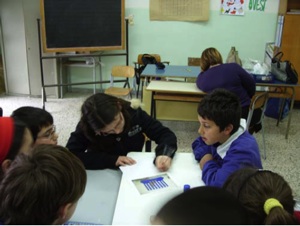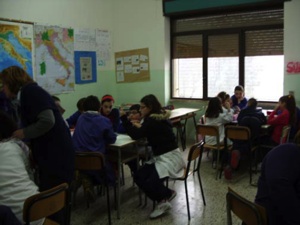
Reality seen through mathematical eyes

 |
Fractions and us Reality seen through mathematical eyes |
 |
8° circolo didattico Brindisi |
||||||||||||||
| Age: 10-11 Lesson 1 Aims: • Putting on a wall chart expressions which exprime concrete situations related to fractions; • Completion of cards. • To bring back pupils' knowledge and abilities acquired in the past years related to the concept of fraction; • To think over fraction's use in everyday life. Materials:
Lesson 2 Aims: To get from pupils' ideas common situations which can represent fractions' examples; To consolidate pupils' fraction concept as “operator” on a quantity. Introduction: Teacher drives pupils to notice that their own class group can be considered as a “whole” from which it is possible to obtain different fractions. He suggests pupils to group themselves according to specific features ( Ex: spectacled pupils; smocked pupils, etc.) in order to “fractionize” class group. Then, according to specific features picked out by pupils, teacher arranges different groups.
Roundup: Lesson 3 Aims: To foster pupils' cooperation. Materials: Introduction:
The game consists to observe photos' subjects and to draw some possible fractions from them. When time's up, each team gives to teacher its written proposals; after that, teacher gives pupils the possibility to observe the three photos in order to compare all the answers and to decide together the winning team. Roundup: Team game , supported by a right completion, can always be a valid way to foster pupils' learning and cooperation. |
||||||||||||||
 |
 |
|||||||||||||